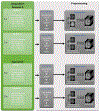Tractography reproducibility challenge with empirical data (TraCED): The 2017 ISMRM diffusion study group challenge
- PMID: 31179595
- PMCID: PMC6900461
- DOI: 10.1002/jmri.26794
Tractography reproducibility challenge with empirical data (TraCED): The 2017 ISMRM diffusion study group challenge
Abstract
Background: Fiber tracking with diffusion-weighted MRI has become an essential tool for estimating in vivo brain white matter architecture. Fiber tracking results are sensitive to the choice of processing method and tracking criteria.
Purpose: To assess the variability for an algorithm in group studies reproducibility is of critical context. However, reproducibility does not assess the validity of the brain connections. Phantom studies provide concrete quantitative comparisons of methods relative to absolute ground truths, yet do no capture variabilities because of in vivo physiological factors. The ISMRM 2017 TraCED challenge was created to fulfill the gap.
Study type: A systematic review of algorithms and tract reproducibility studies.
Subjects: Single healthy volunteers.
Field strength/sequence: 3.0T, two different scanners by the same manufacturer. The multishell acquisition included b-values of 1000, 2000, and 3000 s/mm2 with 20, 45, and 64 diffusion gradient directions per shell, respectively.
Assessment: Nine international groups submitted 46 tractography algorithm entries each consisting 16 tracts per scan. The algorithms were assessed using intraclass correlation (ICC) and the Dice similarity measure.
Statistical tests: Containment analysis was performed to assess if the submitted algorithms had containment within tracts of larger volume submissions. This also serves the purpose to detect if spurious submissions had been made.
Results: The top five submissions had high ICC and Dice >0.88. Reproducibility was high within the top five submissions when assessed across sessions or across scanners: 0.87-0.97. Containment analysis shows that the top five submissions are contained within larger volume submissions. From the total of 16 tracts as an outcome relatively the number of tracts with high, moderate, and low reproducibility were 8, 4, and 4.
Data conclusion: The different methods clearly result in fundamentally different tract structures at the more conservative specificity choices. Data and challenge infrastructure remain available for continued analysis and provide a platform for comparison.
Level of evidence: 5 Technical Efficacy Stage: 1 J. Magn. Reson. Imaging 2020;51:234-249.
Keywords: DW-MRI; HARDI; challenge; in vivo; reproducibility; tractography.
© 2019 International Society for Magnetic Resonance in Medicine.
Figures









References
-
- Jeurissen B, et al., Diffusion MRI fiber tractography of the brain. NMR in Biomedicine, 2017. - PubMed
-
- Tuch DS, Q-ball imaging. Magnetic resonance in medicine, 2004. 52(6): p. 1358–1372. - PubMed
-
- Tournier J-D, et al., Direct estimation of the fiber orientation density function from diffusion-weighted MRI data using spherical deconvolution. NeuroImage, 2004. 23(3): p. 1176–1185. - PubMed
Publication types
MeSH terms
Grants and funding
LinkOut - more resources
Full Text Sources
Research Materials
Miscellaneous

